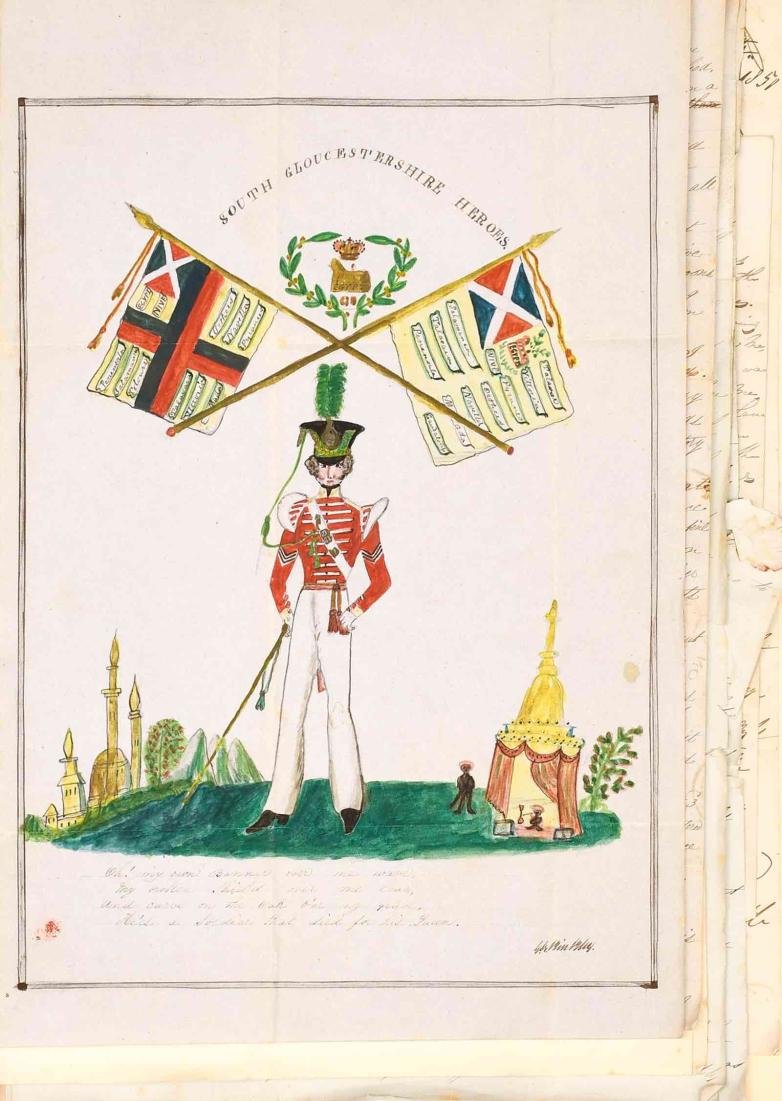Rare Letter Archive From 19th Century Soldier in Ireland and India Sold for £6,500

An original inscribed painting depicting a Sergeant under the battle colours of the South Gloucestershires, sent after Binkley was promotion and signed by him in the lower corner. Part of the archive of letters.
A rare record of army life in the 19th century in the form of an archive of letters written by a soldier has sold for £6,500 in the Books, Maps and Manuscripts Sale at Tennants Auctioneers. It is very unusual to have such a vivid and detailed account written by an enlisted soldier rather than an officer.
The letters were written by G.C. Binkley or J.C. Binkley (the first initial of the signatures appears to change after 1846), mostly to his sister in Nottingham. Binkley was a soldier of the 61st (South Gloucestershire) Regiment of Foot between 1843 and 1849 and was drafted for India. Originally from Nottingham, in 1843 illness forced Binkley to leave his employment in Birmingham and he moved to Cork, where poverty drove him to enlist in the 35th Foot. In 1845 he sailed from Cork to Calcutta, where he endured a 622 mile march to Cawnpore, with elephants and camels carrying the baggage, and his account of the march included details of an arranged tiger fight and numerous deaths amongst the company.
The letters then go on to detail his promotion to sergeant, his marriage to the widow of the regimental tailor, and numerous battles during the Second Sikh War in 1848.
Also selling well was an outstanding archive of letters written to clan chief The Mackintosh of Mackintosh, the majority of which are personal autographed letters from the British Royal Family (sold for £1,400). Written in the first half of the 20th century, many of the letters discuss shooting at Moy Hall, the seat of the Chief of Clan Mackintosh, and were written by King George V, Prince Edward (later King Edward VIII), and Prince Albert (later King George VI).
In addition, there are letters from Queen Mary, the Duchess of Albany, and the last letter written by The Mackintosh’s son, Angus, before he died in North America in 1918. Alfred Donald Mackintosh of Mackintosh (1851-1938) was the 28th Chief of Clan Mackintosh and Chief of Clan Chatton. He and his wife divided their time between Moy Hall, near Inverness and Cottrell House in Glamorgan, his wife’s family home. A great friend of King George V, he devoted a great deal of his time to hunting, shooting, and fishing.
Further notable lots included a collection of 18 early photographs of mountains by Vittorio Sella (1859-1943), that were sold in three lots achieving a total hammer price of £3,700. Sella photographed some of the most challenging summits across four continents, many of which had never been photographed before. This collection of large format silver print photographs was purchased in 1945 by the vendor’s father, a British Army Captain, whilst stationed in Biella.
An interesting manuscript diary giving a unique insight into the life of a young aristocrat and army officer in the late 19th century sold well at £800. Covering the period between 25th March and 31st December 1878, the diary is thought to have been penned by William George Frederick Cavendish Bentinck (1856-1948), father of the 8th and 9th Dukes of Portland and husband of the socialist suffragette Ruth Cavendish Bentinck.
The fascinating diary details military training, dinners and London balls, theatre and racing trips, hunting, the House of Lords, grouse shooting, house parties at country estates including Sledmere and Nun Appleton, and a tour of France and Italy. A Royal Navy Signal Book for the Ships of War Day and Fog from circa 1796, containing an original ownership inscription for Richard Brinsley Tickell, son of Richard Tickell, playwright and satirist, sold for £1,300, and an intriguing manuscript account of the Lake District Wedding of Mr and Mrs Edward Benham in September 1852 sold for £1,000.
Having married in Colchester, the happy couple travelled to the Crown Hotel overlooking Bowness, Windermere. The account details boat trips, hill climbing, a horseback excursion to Langdale Pikes, and engraving their initials on a stone on the shores of Coniston Water as a memorial.















